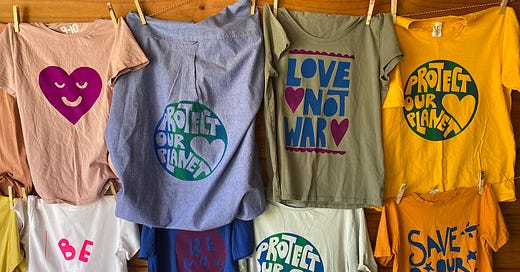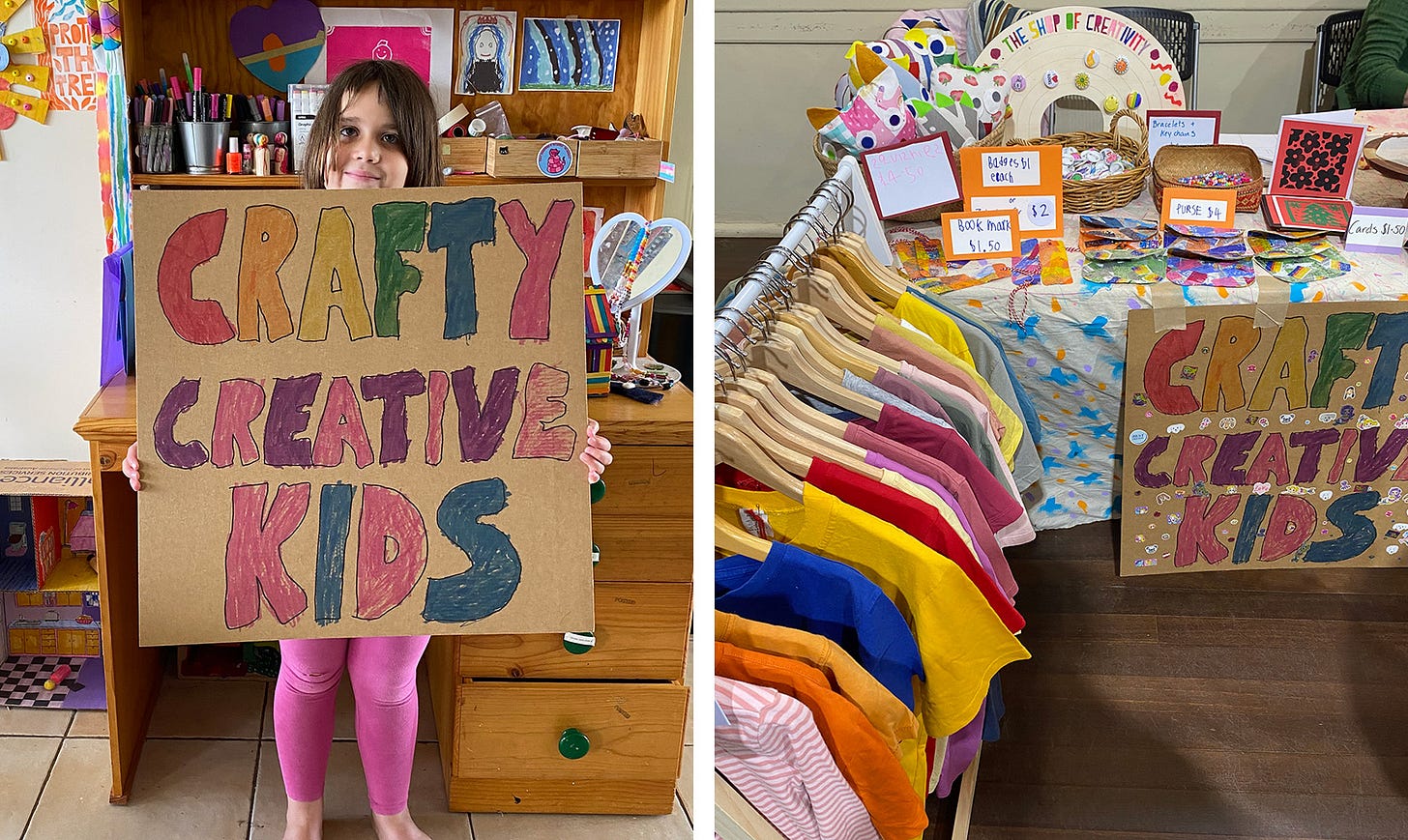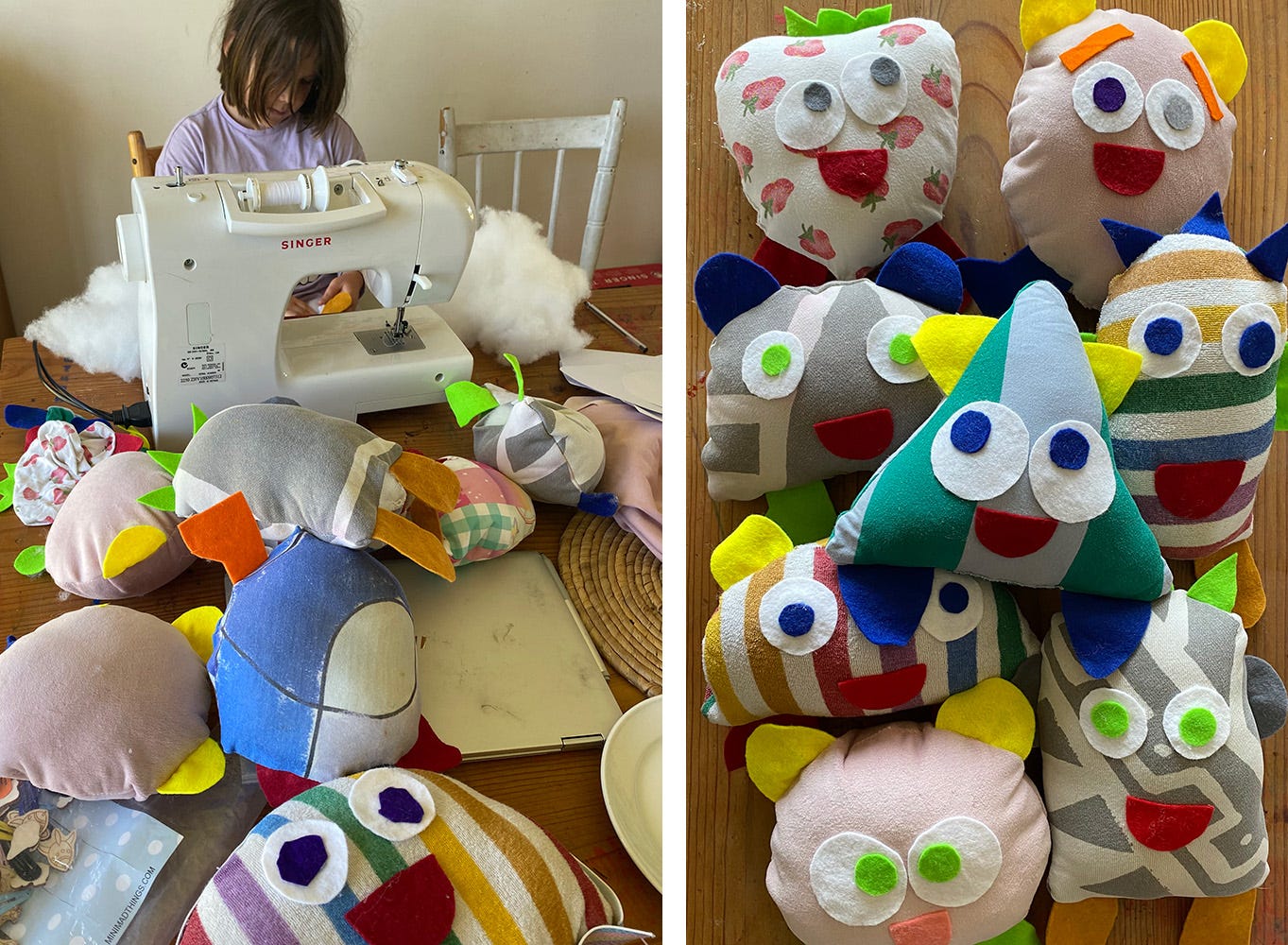In these monthly tales from our art table (aka. The Kitchen Table), I hope to share an honest insight into the creative projects we embark on; successes, failures and the mess left behind. Creativity is at the heart of our family life, not just literally because it takes over the place where we eat, sit and talk, but also in the way we live and approach learning together. It permeates everything; mathematics, science, literature, the way we fix things that are broken and solve problems together as a family. So inevitably the paint covered brushes of our artworks will be mixed with the politics of our daily lives in these stories from our kitchen table.
For some context, I have two children, H who is 10 and F who is 7. We currently live life and home educate in South Australia, along with my partner.
It’s been a few months since I have written one of these articles sharing the creative projects we have embarked on at home. Life has been busy and although we have been doing a fair few crafty things, I just haven’t had the time to sit down, reflect and write.
Over the last month, my children have been preparing for an annual child entrepreneur market they take part in. The market is run by some families in our local home education community.
This year we collaborated with another family and decided to share a stall. That last sentence made the process of deciding to work together sound very simple. It was far from simple. The journey to collaborating began with a conversation I had with a friend (the mother of another home education family). We (the adults) thought it would be a nice idea to work together, lightening the load of work needed to prepare, sharing creative skills and making fun crafty products to sell together. Sounds great right? Well, when we proposed this idea to the children, we were not initially met with enthusiasm.
Let me set the scene a little before I continue. All the children involved are home educated in a very non-competitive, self-directed and supportive culture. We actively avoid comparison and judgement against peers. Their education is about their personal growth, not their position in graph compared to other children. We are also all families that actively divest from capitalist ideas around hording wealth and buying all the shiny things.
Back to our proposal of collaboration…
When we suggested the idea of working together, we (the adults), proposed that we would all contribute in making items to sell and all the money earned would be shared equally between everyone involved. This simple concept, that seemed fair to us, was met by many (totally valid) questions. Questions like, ‘What if I make more things than someone else, shouldn’t I get more money?’, ‘What if the things someone makes don’t sell, should they still get paid?’ and ‘Do the younger children, who aren’t as good at making things, still get the same amount to money?’ A few of the children involved were very upset at the idea that they would have to share their hard earned money with others. Their immediate response to our proposal of collaboration and sharing was met with a NO. They wanted to go it alone. They wanted to have individual stalls and keep all their own money, even if it meant being in competition with their friends. The idea that they ‘could’ possibly make more money than their friends was very appealing.
Myself and the other mum involved were a little caught off guard by their reaction to our proposal. It was surprising to us that, these children who have been raised is a very non-competitive, anti-capitalist families, chose capitalism. They wanted the chance to win; to beat their friends and keep all the money themselves.
This lead to a very interesting discussion. I put forward a question to the children; ‘What happens if you don’t win? How will you feel if you go it alone and don’t sell anything?’ They hadn’t really considered the other side of the story, that for some people to win, others had to loose. I explained that there was a finite number of people attending the market, each with a certain amount of money to spend. Working alone, there is a chance that you might be able to get a larger slice of that money pie but there is also a big chance that you might get less.
I explained that we all have different strengths and weaknesses. Some people have awesome crafting skills, others might be really good at talking to people and selling, some might be great at calculating change and handling money, others might love working on the display of our stall. If we pooled our skills and resources; if we worked together and supported each other, as a whole we would be stronger. Working together as a collective, we might get a little less money each, but we would be working with friends not against them.
In the end the kids chose socialism. We all worked together and had a great time.
During the discussions, I also proposed a communist approach to running the stall; the parents keep all the money and resources for themselves, giving each child and very small but equal amount of money for their work. This idea was met with a big NO thank you!
UP-CYCLED SOFT TOYS
Let’s get to the creative stuff...
One of the products my daughter made to sell was some soft toys, she called Squishies, made from the fabric of old t-shirts and sweaters. I helped her cut all the fabric, then she stitched the little creatures together on the sewing machine, stuffed them, glued on the eyes. She worked all day making these cute little critters and was so proud of her creations.
BADGE MAKING
One of the most fun bits of craft equipment I have purchased over the last few years is a badge maker. The kids absolutely love designing and creating their own cute badges. For the market, my son made 100’s of cool badge designs.
UP-CYCLED SCREEN PRINTED T-SHIRTS
This was my favourite project we worked on together for the market stall. We brought lots of second hand t-shirts and screen printed cool designs. We chose a very simple method of screen printing, creating paper stencils which we then used to mask the ink going onto the t-shirts. Keeping it simple meant that the kids could come up with their own design ideas. I also made a few of my own designs too!
FINAL THOUGHTS
I’m not sure why I was caught off guard by the children’s initial gravitation towards capitalism. Capitalist ideas are pervasive in everything we do; in children’s TV shows, music videos, magazines, books, computer games and in every town main street. In every community event we visit, celebration or show there are snacks, souvenirs or trinkets to buy. You can’t just go to a local Christmas pageant or community fete without there being stalls of plastic rubbish enticing children (and adults) to spend money on stuff they don’t need. We can’t just enjoy an experience, there has to be stuff to buy too!
It feels like an uphill battle to counteract that capitalist consumerist message our children hear and see every day. We try to not buy things that we don’t need, to purchase second hand or repair items we already have, to give freely to charities or our community without expecting anything in return. We try but I’m not sure it is enough to counteract the shiny newness of buying stuff. It is an uphill battle but I’m not going to give to trying to live a different way.
My monthly ‘Tales from our Table’ articles will always be free, but if you are looking to more creative ideas, to delve deeper into art techniques or to receive free printables, please consider becoming a paid subscriber to Creative Spaces.








